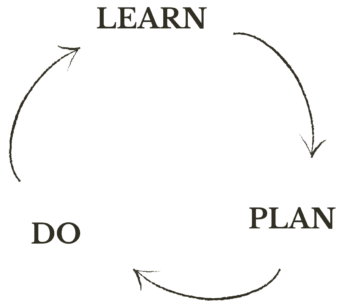Welcome.
Tending the Land for Fire Resilience in Sonoma County is a guide for anyone living or working in Sonoma County interested in stewarding land to achieve a variety of goals, from developing fire resilience to conserving water, enhancing wildlife habitat, and more.
Tending the Land is meant to inform and empower land stewards of all kinds, from individuals to community groups to professionals. We hope it is the first resource that land stewards reach for.


LEARN:
OBSERVE & ADAPT
Stewarding the land is an ongoing process. This guide makes suggestions for how to observe, monitor, and adjust, along the way.
PLAN:
GOALS & DESIGN
This guide encourages you to get clear on the values that drive your land stewardship and the outcomes you seek.
DO:
IMPLEMENT & MAINTAIN
This guide describes in detail where, when, and how to use 20 of the most common vegetation management practices.
This guide is for land stewards of all kinds…
- Landowners and landowner groups
- Volunteers, tenants, and community members who help care for open space lands
- Professionals, especially early-career or transitioning professionals
The guide presents knowledge from numerous Sonoma County experts and makes it accessible. Tending the Land helps you understand, plan, and execute land stewardship practices in the wider landscape beyond defensible space.


See the companion website Resilient Landscapes for how to create and maintain ecologically rich defensible space around structures and roads.
Read real stories from Sonoma County stewards and land managers: what they’ve done and why, and how it’s worked out.
Rather than dictating a singular approach, this guide offers a range of options, outlining their advantages and disadvantages, to ensure land stewards feel confident the decisions they make are aligned with their goals and their particular site.
Why Sonoma County Needs Tending the Land
Sonoma County has a stunning diversity of natural beauty: from rolling hills and grasslands dotted with oaks and bay laurels to a dramatic coastline with iconic coastal redwoods. These landscapes provide clean air, water, food, and cultural resources; they also sequester carbon, and host some of the most biodiverse plant and animal communities on earth.
Sonoma County has a long history of protecting open spaces. Now these places face new challenges: severe droughts, floods, heat, and wildfires, accelerated by climate change. Six of Sonoma County’s seven largest wildfires on record have occurred since 2017. Fire suppression and exclusion of Indigenous stewardship from the land have substantially changed the composition of Sonoma County’s woodlands over the last 200 years. In some areas, Douglas fir coverage has increased ten or more times. Studies across the West show overcrowding of forests, and a growing body of research links abundance of fuels with more severe wildfires.
Fortunately, Sonoma County has vast expertise in active land stewardship. This project is a collective effort to distill this knowledge into an accessible guide. If you are new to this topic, we recommend that you review the Learn and Plan sections first. If you are an experienced practitioner, then the Do section will likely be most helpful.
Land in Sonoma County has been traditionally stewarded for millenia and this supported multiple benefits. If you engage in informed, active stewardship, you can have the same.
Land stewardship is a never-ending process of learning, trying different practices, observing the results, adjusting approaches, and returning to this cycle again and again. The unexpected will occur but Tending the Land offers background information and approaches to help avoid regrets.
While it can feel overwhelming at times, the rewards are also extremely gratifying. Clint McKay (Wappo, Pomo, Wintun) often notes, caring for forests or grasslands in our own backyards or favorite parks can help us express our respect and gratitude for the clean air, water, and beauty it offers, and develop a true sense of home that can’t be earned in any other way.
To learn more about the authors, contributors, partner organizations, and funders of this guide, visit the About page.
Land Acknowledgement
Sonoma County is located on the unceded land of the Kashia Pomo, Southern Pomo, Coast Miwok and Wappo people. We honor with gratitude the past and present Indigenous people who have stewarded this land throughout generations. Learn more about the tending practices of local Native tribes and visit tribal websites:
Federated Indians of Graton Rancheria
Dry Creek Rancheria Band of Pomo Indians
Cloverdale Rancheria of Pomo Indians
Kashia Band of Pomo Indians of the Stewarts Point Rancheria
Lytton Band of Pomo Indians
California Indian Museum and Cultural Center (Santa Rosa)
Steps to Land Back: Wappo and Sugarloaf Ridge State Park
Redbud Resource Group

A map of traditional Indigenous territories in what is now called Sonoma County. https://native-land.ca/









